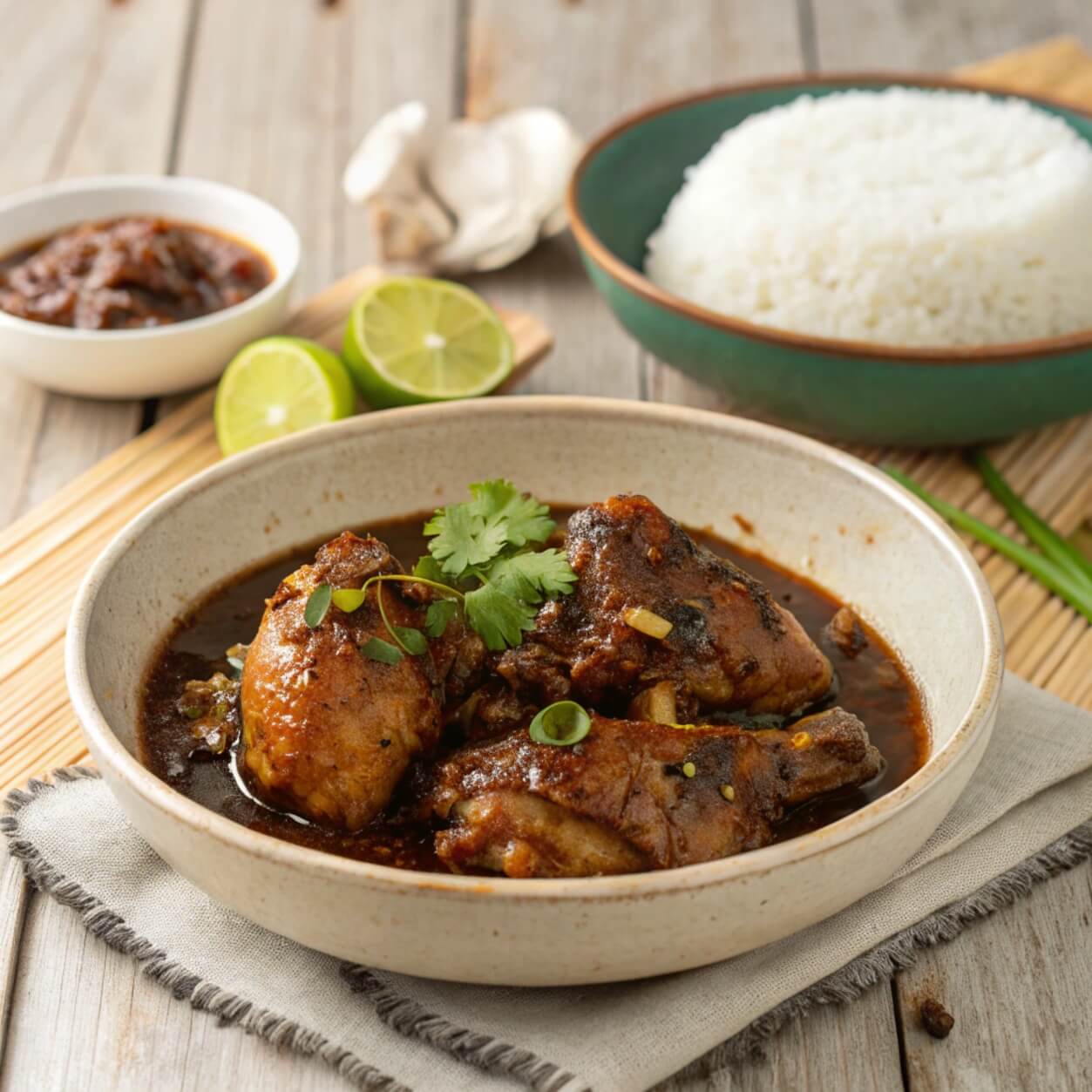How to Cook Chicken Adobo Recipe
Chicken adobo is the Philippines’ national dish, a tribute to its rich culinary legacy. This flavorful, acidic dish combines chicken pieces marinated in vinegar, soy sauce, garlic, and spices, then cooked until the meat becomes tender and the sauce reduces to a glossy glaze. Although the cooking technique predates the Spanish colonization of the Philippines, “adobo” derives from the Spanish word “adobe,” meaning to marinate.
Passed down through the years, families throughout the Philippines have unique takes on Adobo. While some people like a saltier character with more soy sauce, others use more vinegar for a sharper flavor. Many Filipino homes feature this meal at least once a week as a useful dish. The vinegar and soy sauce naturally preserve the meat, extending its life in heated conditions.
What distinguishes chicken adobo is its straightforwardness. Using just a few items often found in most homes, you can prepare a meal that satisfies and comforts with a rich taste. The mix of sour, salty, and somewhat sweet elements provides a wonderful symphony that has made this dish renowned in the Philippines and globally.
Essential Ingredients for Authentic Chicken Adobo
To create classic chicken adobo, you need these essential ingredients:
- Chicken parts – Bone-in, skin-on chicken thighs and drumsticks work best since they keep juicy over the extended cooking procedure
- Vinegar – Filipino chefs traditionally use cane vinegar (sukang maasim); however, white vinegar or apple cider vinegar can be used as a substitute.
- Soy sauce – Provides the salt ingredient and rich color
- Garlic – Lots of it, smashed or coarsely chopped. Bay leaves – Add delicate herbal flavors
- Whole black peppercorns – For moderate heat and scent
- Optional ingredients – Some versions incorporate sugar, coconut milk, or chili peppers
The beauty of Adobo resides in its adaptability. The fundamental ratio follows a 1:1 proportion of vinegar to soy sauce, although you may vary according to your taste preferences. In some areas in the Philippines, add coconut milk for a creamier sauce, while others incorporate a little sugar to temper the tanginess.
What separates Filipino Adobo from other vinegar-based dishes is the cooking method. The meat marinates first, then is cooked in the same marinade until tender. Then comes the critical step—the sauce thickens while the chicken browns, producing a rich glaze that coats each piece.
Step-by-Step Cooking Process
Preparing Your Ingredients
Before you start cooking, prepare all your ingredients. Cut a whole chicken into serving pieces, or use your chosen chicken parts. Crush or chop 6 to 8 garlic cloves. Measure equal amounts of vinegar and soy sauce (usually ½ cup each for around 2 pounds of chicken). Have 3-4 bay leaves and one tablespoon of whole black peppercorns available.
Marinating the Chicken
For the finest taste, marinate the chicken beforehand. In a large bowl, mix the chicken with the vinegar, soy sauce, garlic, bay leaves, and peppercorns. Mix thoroughly to coat each piece. Cover and refrigerate for at least 30 minutes; marinating overnight creates even deeper flavors.
Cooking Method
- Transfer the chicken and marinade to a big saucepan or deep skillet.
- Bring to a boil over medium-high heat, then reduce the heat to a simmer.
- Cover and simmer for approximately 30 minutes or until the chicken is cooked.
- Remove the top and raise the heat to medium-high.
- Continue simmering until the sauce has reduced and thickened, approximately 10-15 minutes.
- Turn the chicken periodically to brown on both sides, then cover it with the glaze.
- The meal is finished when the chicken is browned correctly, and the sauce has reduced to a thick consistency.
The secret to excellent Adobo is patience. Let the sauce decrease gradually without hurrying the process. This concentrates the flavors and provides that trademark sticky, glossy coating on the chicken. The completed meal should have a great combination of salty, acidic, and savory flavors, with chicken that is so tender it practically falls off the bone.
Common Mistakes to Avoid
When preparing chicken adobo for the first time, look out for these typical errors:
- Using too little vinegar – Don’t be frightened of vinegar; it mellows during cooking
- Skipping the browning phase – This key step produces taste and texture
- Cooking at too high heat – Slow simmering works best for delicate meat
- Adding too much water – The marinade should offer enough liquid
Variations of Chicken Adobo
Regional Filipino Variations
Across the Philippines, you’ll discover several regional variants of this traditional dish:
- Adobong Puti (White Adobo) – From the Visayas area, utilizes no soy sauce, just salt, resulting in a light tint
- Adobo sa Gata – Popular in Southern Luzon, adds coconut milk for a creamy sauce
- Adobong Dilaw – From Batangas, utilizes turmeric instead of soy sauce for coloring
- Adobo sa Asin – A saltier variant utilizing fish sauce or plain salt instead of soy sauce
Each variety reflects local ingredients and tastes, keeping the essential cooking procedure that characterizes Adobo.
Modern Interpretations
Contemporary chefs continue to experiment with Adobo:
- Adobo Flakes – Shredded adobo beef, fried till crunchy, great for breakfast with eggs
- Adobo Fried Rice – Leftover Adobo diced and incorporated with garlic fried rice
- Fusion Adobo – Incorporating non-Filipino elements such as balsamic vinegar, honey, or chili paste
- Vegetarian Adobo – Using mushrooms, tofu, or tempeh instead of chicken
These innovative variations highlight the adaptability of Adobo’s taste profile while respecting its roots.
How to Make Pulao Rice as a Side Dish
Pulao rice is a fantastic partner to chicken adobo, delivering a savory alternative to plain steamed rice. The fragrant spices in pulao wonderfully complement the tangy-savory flavor of Adobo.
Essential Pulao Ingredients
For a simple pulao that feeds 4-6 people, you’ll need:
- 2 cups basmati rice, washed and soaked for 30 minutes
- 4 tablespoons ghee or vegetable oil
- 1 big onion, thinly sliced
- 2-3 bay leaves
- 4-5 cloves
- 1 cinnamon stick
- 4-5 cardamom pods
- 1 teaspoon cumin seeds
- 4 cups water or broth
- Salt to taste
Cooking Process for Basic Pulao
- Heat ghee or oil in a heavy-bottomed saucepan over medium heat.
- Add the entire mixture of spices (bay leaves, cloves, cinnamon, cardamom, and cumin) and cook for 30 seconds, until aromatic.
- Add sliced onions and sauté until golden brown, approximately 5-7 minutes.
- Drain the soaked rice and add to the saucepan, carefully swirling to coat each grain with the fragrant oil.
- Add water or broth and salt, and bring to a boil.
- Reduce heat to low, cover closely, and simmer for 15 minutes.
- Remove from heat and let rest, covered, for 10 minutes.
- Fluff with a fork before serving.
The final pulao should have distinct, airy grains, each infused with the scent of the entire spice blend. The onions provide flavor and texture, making the dish more fascinating than plain rice.
Variations of Pulao to Serve with Adobo
While classic pulao goes great with Adobo, you may try these variations:
- Vegetable Pulao – Add mixed veggies, including carrots, peas, and bell peppers
- Coconut Pulao – Replace part of the water with coconut milk for a creamier flavor that works wonderfully with Adobo
- Citrus Pulao – Add a squeeze of lemon or lime juice at the end to accentuate the Adobo’s tanginess
- Herb Pulao – Mix in chopped cilantro and mint leaves before serving
When pulao is mixed with chicken adobo, the rice absorbs the rich sauce, resulting in a complete meal that combines Filipino and South Asian culinary traditions.
Serving Suggestions and Food Pairings
Chicken adobo is typically served in a large dish at the table, with the reduced sauce poured over the chicken. Here are some perfect accompaniments:
Traditional Filipino Side Dishes
- Steamed Rice – The most frequent accompaniment, great for soaking up the sauce
- Atchara – Pickled green papaya gives a pleasant contrast
- Ensaladang Talong – Grilled eggplant salad with tomatoes and onions
- Pinakbet – Vegetable stew with bitter melon, eggplant, and squash
Drinks and Desserts
Complete your adobo dinner with the following:
- Calamansi Juice – A zesty Filipino drink that cuts through the richness
- San Miguel Beer – A classic Filipino beer that works nicely with delicious Adobo
- Halo-halo – A multicolored shaved ice treat for after the meal
- Leche flan – Creamy caramel custard that contrasts with Adobo’s savory overtones
Chicken adobo is more than just a recipe—it embodies Filipino heritage, ingenuity, and family tradition. Its basic preparation conceals the rich tastes that emerge when vinegar and soy sauce transform ordinary chicken into something remarkable.
The beauty of Adobo resides in its versatility. You can vary the vinegar-to-soy ratio to suit your taste, add coconut milk for a smooth texture, or incorporate chiles for spiciness. Serving it with fragrant pulao rice provides a cross-cultural dining experience that highlights the complementary flavors of Filipino and South Asian cuisines.
Perhaps what makes Adobo genuinely exceptional is how it improves with time. Many Filipino chefs purposefully produce extra, knowing that the flavors intensify and mingle after a day or two in the refrigerator. This practical aspect—cooking once and enjoying numerous meals—explains why Adobo remains a mainstay in Filipino families worldwide.
By mastering this chicken adobo recipe and its complementary dish, pulao rice, you add meals and tales to your culinary arsenal. Each time you cook them, you link with centuries of history while developing your variety to pass along. That’s the essence of excellent cooking—honoring the past while making it your own.











